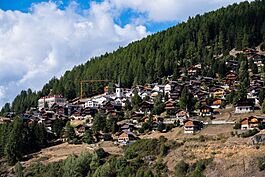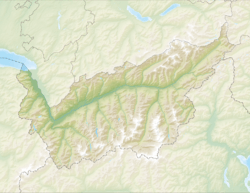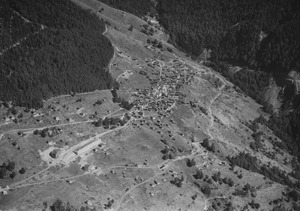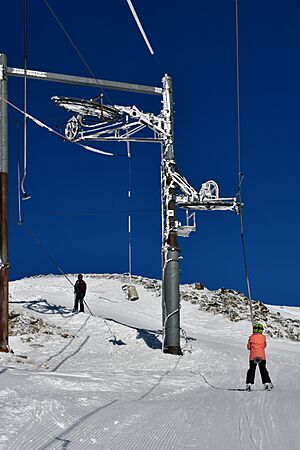Saint-Luc, Switzerland facts for kids
Quick facts for kids
Saint-Luc
|
||
|---|---|---|

General view of Saint-Luc
|
||
|
||
| Country | Switzerland | |
| Canton | Valais | |
| District | Sierre | |
| Area | ||
| • Total | 31.9 km2 (12.3 sq mi) | |
| Elevation | 1,655 m (5,430 ft) | |
| Population | ||
| • Total | 312 | |
| • Density | 9.781/km2 (25.33/sq mi) | |
| Postal code |
3961
|
|
Saint-Luc is a charming village located in the Valais region of Switzerland. It's part of the Sierre district.
Once an independent town, Saint-Luc joined with several nearby villages on January 1, 2009. These villages included Ayer, Chandolin, Grimentz, Saint Jean, and Vissoie. Together, they now form the larger municipality of Anniviers.
Contents
A Look Back in Time
Saint-Luc was first mentioned in old records in 1267, when it was called Lus. Later, in 1304, its name changed to Luc, which was its official name until 1904. The name Saint-Luc, as we know it today, first appeared around 1850.
In 1858, a big fire destroyed much of the village. This event led to important changes in how the traditional wooden chalets were built and designed.
Village Symbol: The Coat of Arms
A coat of arms is like a special symbol or logo for a place. Saint-Luc's coat of arms has a blue background. From a golden ribbon, three green pine trees grow, showing the natural beauty of the area. There is also a silver ox walking across the design.
Who Lives in Saint-Luc?
As of December 2015, Saint-Luc had a population of 340 people.
Most people in Saint-Luc speak French as their main language. In 2000, about 83.1% of the population (265 people) spoke French. The second most common language was German, spoken by about 6.9% (22 people). Portuguese was the third most common, spoken by 5.0% (16 people). There were also 8 people who spoke Italian.
In 2000, about 34.5% of the people living in Saint-Luc (110 people) were born there. Another 27.3% (87 people) were born in the same canton (Valais). About 16.6% (53 people) were born elsewhere in Switzerland, and 20.7% (66 people) were born outside of Switzerland.
In 2000, there were 135 single people in the village who had never been married. There were 154 married people, 16 widows or widowers, and 14 divorced individuals.
The village had 32 households where only one person lived. There were also 11 households with five or more people. In 2000, 120 apartments were lived in all year round. Many apartments (845) were used only during certain seasons, like for holidays. A small number (55) were empty.
The chart below shows how the population of Saint-Luc has changed over many years:

Jobs and Work
In Saint-Luc, 165 residents had jobs. About 42.4% of these workers were women. In 2008, there were 167 full-time equivalent jobs in the village. This means if you add up all the hours worked, it would be like 167 people working full-time.
Jobs are divided into different groups:
- Primary sector: 14 jobs were in this group. This includes jobs like farming (3 jobs) and working with forests or lumber (11 jobs).
- Secondary sector: 14 jobs were in this group. Most of these (13 jobs) were in manufacturing, which means making things. One job was in construction.
- Tertiary sector: 139 jobs were in this group. This includes service jobs like selling or repairing cars (14 jobs), moving and storing goods (17 jobs), working in hotels or restaurants (67 jobs), and teaching (6 jobs).
In 2000, 37 workers traveled into Saint-Luc for their jobs, while 72 workers traveled out of the village to work elsewhere. This means more people leave Saint-Luc for work than come into it.
Beliefs and Churches
Based on the 2000 census, most people in Saint-Luc were Roman Catholic, making up 84.3% of the population (269 people). About 7.8% (25 people) belonged to the Swiss Reformed Church.
A small number of people (1 person) belonged to another Christian church. There were also 21 people (about 6.58%) who did not belong to any church, or were agnostic (meaning they don't know if God exists) or atheist (meaning they don't believe in God). Three people did not answer the question about their religion.
Learning and Schools
In Saint-Luc, about 37.6% of the population (120 people) had finished upper secondary education. This is like high school. Another 14.7% (47 people) had completed higher education, such as going to a university or a specialized college called a Fachhochschule. Of those who completed higher education, 48.9% were Swiss men, 31.9% were Swiss women, and 14.9% were non-Swiss men.
In 2000, 67 students from Saint-Luc went to schools outside the village.
Saint-Luc Ski Resort
Saint-Luc is well-known for its ski resort, which is located high up in the mountains, around 2,200 meters (about 7,200 feet) above sea level. This resort is connected to the Chandolin ski resort, forming the "Saint-Luc - Chandolin Ski Domain."
This ski area has 12 ski lifts, including 8 skilifts, 3 chairlifts, and 1 funicular (a type of mountain railway). There are also 65 kilometers (about 40 miles) of ski runs. The main meeting points for skiers are at Tignousa, which is 2,180 meters (about 7,150 feet) high, and at Tsapé in Chandolin, at 2,475 meters (about 8,120 feet). The lowest point of the resort is at 1,680 meters (about 5,510 feet), and the highest is at 2,965 meters (about 9,730 feet), both on the Saint-Luc side.
History of the Ski Resort
The Saint-Luc ski resort began in 1959 with the Combettaz ski lift. This lift was later replaced by a chairlift in 1964. At the same time, the main lift of the resort, Tignousa, was built. Before these, Chandolin had already built a Poma skilift in 1961 called Illhorn, which took skiers from the village to the top of the Illhorn peak.
In 1965, the Par-di-Modzes skilift was built for young skiers, but it was closed in 2018. The next year, the Foret skilift was added. This lift went through a forest and was updated many times before being replaced by a chairlift in 2015. Two years later, the Col des Ombrintzes skilift started running.
In 1971, Chandolin added the Tsape chairlift and the Etables skilift. In 1973, the Pas de Boeuf ski lift was opened to reach the Bella-Tola area. This lift was over 2 kilometers long, making it the longest Poma lift in Switzerland at the time.
After some quiet years, the Cret de la Motte Poma lift was built in 1981, but it was not very popular and was closed in 2012. The next year, the Bela-Tolla skilift opened, allowing access to the peak of the same name, which became the highest point of the resort. Even though the peak is 3,025 meters high, the lift only goes up to 60 meters below it.
In 1985, the "Ecole" (School) lift was built for young skiers learning at the Swiss Ski School of Saint-Luc. Around this time, Saint-Luc and Chandolin started planning to connect their two ski areas. In 1986, the Rotsé chairlift was built, allowing skiers from Chandolin to reach Saint-Luc by ski for the first time. To help Chandolin skiers return, the Col des Ombrintzes skilift was made longer.
Seven years later, in 1993, the Illhorn skilift was updated and split into two shorter parts because the original lift was very long and difficult. The following year, the Combettaz chairlift was replaced by the Funiculaire St-Luc – Tignousa, a funicular railway built to be more environmentally friendly. At the same time, a new skilift similar to the Ecole lift was built in Chandolin, named Tsa. After these changes, no more new lifts were built, except for replacing the Foret lift in 2015 and shortening the Rotse lift in 2020.






